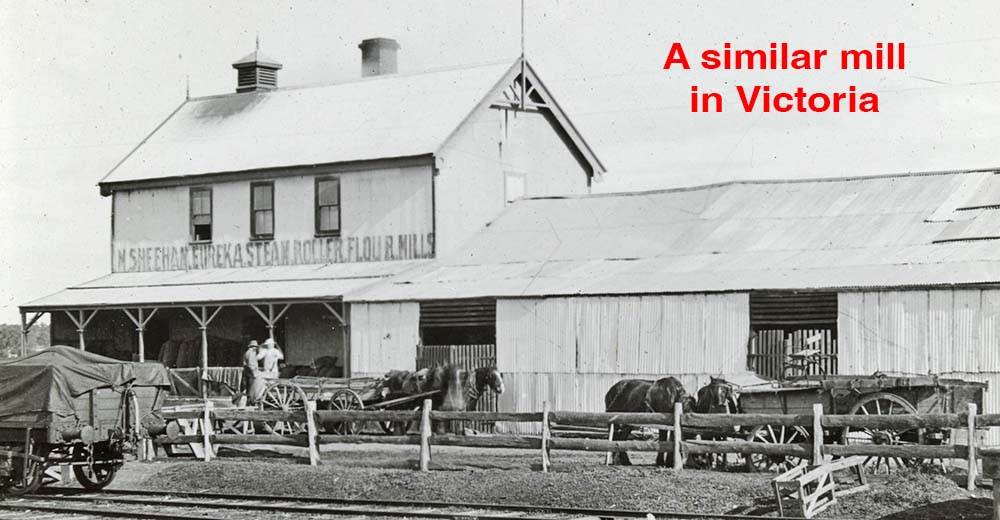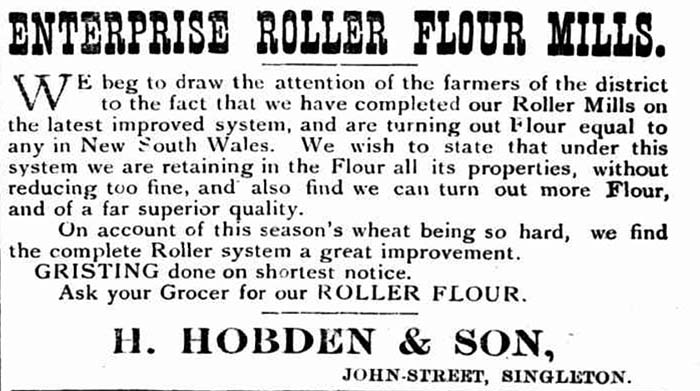
Henry Hobden's Enterprise Steam Flour Mill
aka Enterprise Patent Roller Mill, Henry Hobden's Mill
Singleton Mills homepage > Mills at Singleton > Enterprise Mill at Singleton township
In 1888, Henry Walker Hobden and his son, Albert Henry Hobden, opened a new steam flour mill in John Street, Singleton, NSW. It used an advanced milling technology called the 'Roller Mill'. They named their new mill, the 'Enterprise Roller Mill'

The locations of eight mills built in Singleton township in the 1800s.
Descriptions of the Enterprise Mill
Key Facts about the Enterprise Mill Our research indicates that this mill was located at what was 80 John Street, Singleton, on the river side of the street, close to the intersection with York Street. The mill building was 38 ft long by 24 ft wide and 22 ft high. Judging from its height, it would have been two to three storeys high. It was made of weatherboard. It had a brick chimney stack. The steam engine was ten horse power. |

No photographs have yet been located of the Enterprise Roller Mill in Singleton. However, from descriptions of this mill, it may have been similar in appearance to this Eureka Roller Steam Mill in Victoria, except that the Enterprise Mill was constructed from weatherboard. Image source: State Library of Victoria. Photographer: W.H. Ferguson.
An announcement of the opening of Henry Hobden's Mill was published in 1888:
"THE ENTERPRISE PATENT ROLLER STEAM FLOUR MILL.- Our esteemed townsmen, Messrs. Henry Hobden and Son, have just opened their new steam flour mill under the above name in John street, near the Benevolent Asylum. The mill is a neat-looking structure built of weatherboards, with a brick chimney stack, the building being of the following dimensions :- Length 38 feet, width 24 feet, height 22 feet. The engine, boiler, and machinery are all new, and the latter is replete with all the latest improvements, including a Eureka scouring and separating machine. Carter and Turner's patent three high roller mill, Carter's centrifugal, Carter's middlings purifier, silk-dressing machinery, and a pair of four feet French stones. The engine of 10 h.p., and the boiler of 12 h.p., are both of Tangye's best make. Altogether no expense has been spared by Messrs. Hobden and Son to have the best and most modern machinery available in order to enable them to give entire satisfaction to their customers. We trust that their spirited undertaking will prove to them a good and "beneficial" enterprise in every sense of the word. Singleton can now boast of four steam flour mills, all of them being situated in John-street." [1] |
The four active flour mills in John Street referred to in the last sentence of the above article would have been:
-- the Phoenix Mill,
-- E. B. Sawkins' Hunter River Mill,
-- William Kingston's Railway Mill, and
-- this new Hobden Enterprise Mill.
An advertisement published in 1898 provided more details about the Enterprise Mill. This advertisement promoted the advantages that they claimed for roller mill flour, compared with flour produced using millstones:
"ENTERPRISE ROLLER FLOUR MILL – We beg to draw the attention of the farmers of the district to the fact that we have completed our Roller Mills on the latest improved system, and are turning out Flour equal to any in New South Wales. We wish to state that under this system we are retaining in the Flour all its properties, without reducing too fine, and find we can turn out more Flour and of a far superior quality. On account of this season's wheat being so hard, we find the complete Roller system a great improvement. GRISTING done on shortest notice. Ask your Grocer for our ROLLER FLOUR. H HOBDEN & SON, JOHN-STREET, SINGLETON" [2] |

Above: the advertisement for the Enterprise Roller Flour Mill, published in the Singleton Argus, 18 April 1899.
Closure of the Enterprise Mill
In 1907, Henry Hobden decided to relinquish his milling business and he advertised the flour mill and land for sale as a going concern. [3]
The property apparently failed to sell though, because in 1910, T. W. Ferrington, Cabinet Maker, was placing advertisements for his services in the Hobden's Mill Premises in John Street. [4]
Henry Hobden, then residing in Dulwich Hill, Sydney, finally sold his property to Arthur Royden Holmes in 1915. [5]
Henry Walker Hobden died in Dulwich Hill, Sydney on 1 September 1916, aged 87. [6]
A tender was advertised in 1816 to remove two sheds from the property known as Hobden's Mill in John Street. [7]
Subsequently in 1918, Harold Lancaster constructed a garage on the vacant land previously owned by Hobden's Flour Mill. [8] Lancaster's Garage continued to operate on this site for decades.
Researched by Anne and Les Dollin
References
1. The Maitland Mercury and Hunter River General Advertiser, 18 February 1888.
2. Singleton Argus, 20 December 1898.
3. Singleton Argus, 27 April 1907.
4. Singleton Argus, 16 July 1910, 6 October 1910.
5. NSW Lands Conveyance Document, Book 1066, Number 985.
6. Singleton Argus, 2 September 1916.
7. Singleton Argus, 19 August 1916.
8. Singleton Argus, 24 January 1941.
Learn More
Clayworth, Dot. (2015) The Flour Mills of Singleton (Part 5). H. Hobden and Son, Enterprise Patent Roller Steam Flour Mill. The Singleton Times (Newsletter of the Singleton Historical Society), Issue 212, pp 5-6.
Further Reading
• Overview of Mills at Singleton • The Kurrajong Mills • The Wisemans Ferry Mills